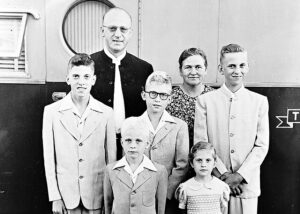It’s been 20 years since Rebecca Harder, now 46, and her husband decided to permanently move into her family’s intergenerational home in Winnipeg’s western suburb of Charleswood.
Harder’s grandparents, Mildred and David “Doc” Schroeder, who passed away last summer and in 2015, respectively, were the original proprietors, both of the 2,400-square-foot house and of the family’s ethic of intergenerational living.
“Grandpa knew that people needed their space, and if we forgot and started to get too enmeshed, he would remind us,” said Harder.

Her mother, Lynette Wiebe, 71, added: “He said the reason we built the house this way was because nobody should have to share a kitchen if they don’t want to. There should be room to breathe.”
But they have also helped one another breathe. When Wiebe was diagnosed with cancer in 2020, Harder said that she lost count of the number of nights she lay beside her mom on the floor to make sure she was breathing. Harder also recalls that when she was a young mom she sent her toddlers to go visit “Nana” when she needed a break, and that when she and her husband couldn’t work during the pandemic, Lynette and husband, Ernie, took over the food budget.
These days Harder is a substitute teacher, while her husband, Matthew, a luthier, works in a studio built in 2012 on the property. Their kids are busy with music and sports. The Wiebes see friends, exercise and participate in activities at Charleswood Mennonite Church.
“My husband and I run from dawn till dusk and . . .” said Harder.
“. . . we wave!” finished Wiebe.

Their model of communal living has changed often, as have the walls in the house. The Harders and their two kids, ages 12 and 14, live in the property’s “back house,” a two-storey addition built in 1980 onto the original 1960s bungalow—called the “front house”—where the Wiebes now reside.
But the family continues to tackle the challenges of sharing a home through open conversation, something Harder witnessed her parents and grandparents doing as she grew up in the house.
Wiebe recalled one tough conversation when she and Ernie were still living in the larger back house, and the Harders asked how long they planned to stay there, given that their young family could use the extra space.
Ernie had built that back-house addition, and Harder knew he didn’t want to leave it. “It was hard for me to bring it up,” she said. “But once the conversation was had . . .”
“. . . it was easy,” finished Wiebe.
A core motivation behind the family’s intergenerational living has been to care for aging parents. At times, there have been four generations living in the house at once, with a total of five generations over the 60 years. The Harders have cared for the Wiebes, the Wiebes for the Schroeders, and the Schroeders for Mildred’s father, Hugo Bartel, who lived in the house until his death in 1982.
Harder said they have prepared a room for her father-in-law, who currently lives in Ontario. “We’ve said, ‘When you are not up to living on your own, you are welcome in this space.’”
Tending to family members’ needs is part of the family’s expression of faith, Wiebe said. “It was definitely a faith-based decision, because the Bible says to love each other…. That kind of practical exploration of loving each other, that comes straight out of our faith.”
As her kids grow, Harder hopes that they learn to talk through hard issues and to keep their eyes open to others’ needs, something that is easier to do when you live so close to your relatives.
“I hope they learn flexibility, open conversation and just to keep loving each other…. And yes, we might be helping [parents or grandparents] more right now, but they’re going to help us real soon. It’ll keep going.”
“It comes around and around,” echoed Wiebe.








Leave a Reply
You must be logged in to post a comment.